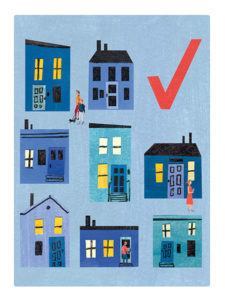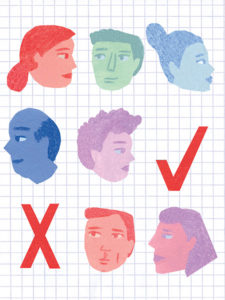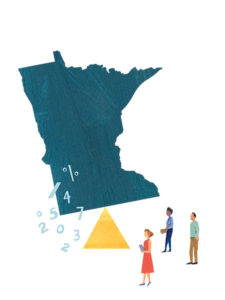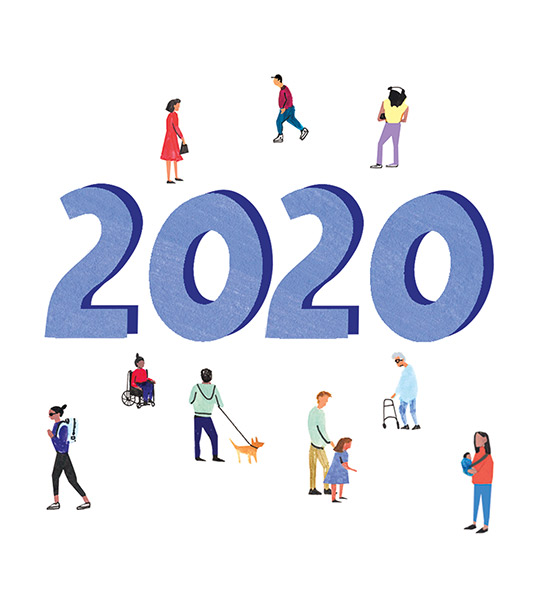
While the political spotlight is on next year’s presidential election, another event, equally important for democracy, will occur in 2020: the census. The nation’s decennial headcount is used for everything from drawing congressional district lines to funding Medicaid. Macalester alumni are helping Minnesota and other states prepare by building relationships that will encourage every single person to stand up and be counted.
“It’s not surprising that people from Macalester are engaged in something that’s as important as the census,” says Andrew Virden ’96, Minnesota’s director of census operations and engagement. “It connects with Macalester’s ideals of internationalism and community service.” For those who aren’t already knee-deep in planning for Census 2020, we offer this introductory course.
Lecture 1: The Overview
Let’s start with the basics. The census is a survey of the entire U.S. population, mandated in Article I of the Constitution and conducted every 10 years for the purposes of apportioning congressional seats. The data are also used for allocating federal funds. Each household fills out the census once for all the people who live there. The form asks about the number of people in the household as well as their sex, age, and race, and whether the home is owned or rented.
While the census is conducted in years that end in zero, preparation begins much earlier. In the months before census day, April 1, the Census Bureau establishes offices in each state and hires hundreds of thousands of census workers. With years of planning and thousands of employees across the country, “the census is our largest civic mobilization outside of going to war,” says Bob Tracy ’82, director of public policy and communications for the Minnesota Council on Foundations.
In 2020, for the first time in history, the census can be completed online. Starting in mid-March, roughly 75 percent of households, generally in parts of the country with broadband internet access, will receive a postcard directing them to the census URL. The other quarter will receive a letter followed by a paper form (these folks also have the option to fill it out online or over the phone). Households that haven’t responded by late April will begin to receive in-person visits from census workers called enumerators. These federal employees, typically hired from within the local community, can visit an address up to three times before census operations cease in the summer.
Lecture 2: What’s at Stake?
The federal government uses census data to determine how to spend its money. That money funds programs like Head Start, school breakfast and lunch programs, foster care, highway construction, student loans and Pell Grants, SNAP (food stamps), and Medicaid—just for starters. Based on the decennial census count, Minnesota, for example, receives $15.5 billion per year from the federal government. That translates into $2,796 per person per year.
Viewed another way: that’s $28,000 per person, over 10 years, that the state loses if the census misses someone. So it pays—literally—to ensure the census is accurate.
 “Accurately counting folks is the way to make sure we get all the money back that we are due for our programs and services,” says Maria Paschke ’11, a former research and outreach coordinator for census activities at the Minnesota State Demographic Center.
“Accurately counting folks is the way to make sure we get all the money back that we are due for our programs and services,” says Maria Paschke ’11, a former research and outreach coordinator for census activities at the Minnesota State Demographic Center.
Equally important, census data determine how many congressional representatives are apportioned to each state. And within the states, the data are used to draw congressional districts as well as boundaries for state, county, and city offices. School district boundaries are based in part on census numbers, as are decisions about where to place fire and police stations.
The census is also used by many entities outside of government. Nonprofits rely heavily on the data, says Paschke, now the head of a nonprofit focused on behavioral health. “When I worked at the state demographic center, some of our most frequent emails and calls were folks from nonprofits asking, ‘What’s the poverty rate in my area?’ ‘How many people of color live in my area?’—trying to get basic information so they could write grants or develop services to better serve the community.”
Businesses use the data to decide where to locate stores, which has ripple effects beyond the companies’ bottom line. “When CVS decides to put a store in your neighborhood, it now means you might be able to walk to get your prescriptions,” Virden explains. “And it means that your neighbor might not have to take a bus and connect three times in order to get to a job. They might be able to just walk across the street.”
Lecture 3: The Census and Political Representation
Article I of the U.S. Constitution mandates a census to apportion representatives “among the several States which may be included within this Union, according to their respective Numbers.” The total number of representatives was capped at 435 by the Permanent Apportionment Act in 1929. Since the 1960s, Minnesota has had eight. The size of the state’s delegation to the Electoral College is also determined by the census: it’s equal to the number of House and Senate members combined.
Minnesotans typically complete the census: in 2010 the state’s 81 percent participation rate ranked second only to Wisconsin’s, a point higher. But Minnesota’s population is not growing as quickly as that in some Southern states. After the 2010 census, Minnesota held on to its eighth congressional seat by a margin of fewer than 8,800 people. The state is again at risk of losing one of its congressional representatives: yet another reason to make sure every household fills out the census.
“We need our voices and our concerns to get to Washington, D.C., and be heard by our national leaders,” says Sharon Sayles Belton ’73, co-chair of the state’s Complete Count Committee. “The best way for that to happen is to get counted and to make sure that we’ve got all the representation that we are entitled to.”
Special Topics: How Redistricting Works in Minnesota
By Karen Saxe, professor emerita of mathematics who served on the Minnesota Citizens’ Redistricting Commission after the 2010 census
“The first step in doing good redistricting is making sure that there’s a good census. Once the census is done, the congressional seats are distributed according to a mathematical formula called the Huntington-Hill method, which has been used since the 1940s. Each state gets one representative, and then, after that, they’re doled out in order, based on population, until the count reaches 435. After the last census, Minnesota got the last seat—seat No. 435.
Once the state knows how many seats it gets, it draws the House districts. Within a state, the districts all have to have roughly equal population, and that information comes from census data. In Minnesota, the House and Senate are supposed to agree on the same map and then pass it on to the governor, who either approves or vetoes it. But that hasn’t happened in a long time, because all three chambers haven’t been run by the same party. This dysfunction created an opportunity for citizens to get involved, and our commission was established to weigh in on redistricting.
The commission had a number of constraints: the new map had to resemble the old map as closely as possible. The districts needed to be as compact as possible. You try to keep communities of interest together by drawing districts that include areas with common geography, culture, and economics. We tried to keep the Twin Cities in one district, as much as possible, but the population distribution across Minnesota requires that the urban area be split into multiple districts. And people move within the state, so even a state that keeps roughly the same number of people may need to adjust district boundaries to account for migration patterns.”
Lecture 4: Challenges for Census 2020
Mac alumni likely are aware of the Trump administration’s attempt to add a citizenship question to the 2020 census. Advocates for immigrant communities worried that the question would have a chilling effect, and that undocumented or mixed-status households would forgo completing the census altogether. The question was ultimately struck down by the Supreme Court, but it contributed to the administration missing its own July 1 deadline to start printing materials.
Although the citizenship question was nixed, Census 2020 is still at a disadvantage. Its operations have been funded behind schedule because of repeated disagreements about government spending between Congress and the President, which resulted in the passage of continuing resolutions that kept the government open but delayed appropriations for the census. The delayed funding meant the Census Bureau opened its regional and state offices a few months late.
That’s not all: although it infused additional money into the census in 2018, Congress appropriated relatively less money for Census 2020 than it did Census 2010 during the years leading up to the headcount. As a result, the bureau conducted only a third of the end-to-end tests it intended to run. “The end-to-end tests are sort of a dress rehearsal for the census,” says Charmaine Runes ’15, who studied the census at the Urban Institute in Washington, D.C. “It’s enumerators going around and making sure that they have the right addresses and seeing what the response is like. They also test outreach strategies, particularly for rural and tribal communities.”
Three tests were planned, in Providence, Rhode Island; Pierce County, Washington; and several rural counties in West Virginia. But only the Providence test happened. That’s a problem, because messaging strategies and the logistics of reaching respondents vary widely between cities like Providence and rural areas. The stakes are even higher because this census is the first that will encourage participants to respond online, and because enumerators will be allowed to make half as many visits to each household—three instead of six.
While a digital-first census may save paper and, for some people, time, it also creates challenges.
Some households don’t have computers. And at least a quarter of residents in rural areas of the country don’t have access to broadband internet. In some communities in the west, the only broadband access may be via three laptops at a county library.
The government’s reputation for building websites to handle massive traffic in a short time isn’t stellar: witness the launch of healthcare.gov, the Affordable Care Act Marketplace. “People were having to drive 50 miles to a library site and stand in line to do that,” says Allen Smart ’83, who studies and advocates for rural philanthropy. “There, you had a critical incentive: you needed health insurance. In this case, the incentives are a little more global—resources for your community or state—rather than so personalized.” Rural residents are unlikely to make the same herculean effort for the census.
Lecture 5: Undercounting
 The census can fail to count people for a number of reasons. A household might not have internet access or anyone who’s computer literate. A family could live where a census worker can’t reach them: in a restricted-access apartment building or down a private road in a rural area. People might not complete the form because they don’t understand how important it is, or because they have a negative perception of government.
The census can fail to count people for a number of reasons. A household might not have internet access or anyone who’s computer literate. A family could live where a census worker can’t reach them: in a restricted-access apartment building or down a private road in a rural area. People might not complete the form because they don’t understand how important it is, or because they have a negative perception of government.
“Education around the census is really important,” Charmaine Runes says. “People have different standards for what counts as personal information, so if you get a form that says ‘fill this out,’ and you don’t know what it’s going to be used for, I can understand why people wouldn’t want to fill it out.”
When a household isn’t counted, it doesn’t mean those specific people will be excluded from government services. It just means that the community as a whole has to make do with less. Undercounting a few dozen school-age kids could result in an allocation of money for school lunches that’s tens of thousands of dollars less than it should have been. And the need to fund school lunches, roads, and public health programs cuts across political lines. “The financial incentives for even the most conservative red states or red counties to get the census count right are profound,” says Allen Smart.
Quiz: Who’s at risk of being undercounted? Answers may vary and may include:
- Undocumented and mixed-status households. Even though the citizenship question wasn’t added to the census, Andrew Virden says, “I don’t know that the message has gotten out that it’s no longer on there, that you won’t suffer any consequence for filling this out.” An important message for such households: if you respond to the form before April 15, census workers likely won’t knock on your door. The more questions you answer, the less likely you’ll receive a visit, Virden says.
- Renters, partly because they move more frequently than homeowners, and partly because it can be difficult for enumerators to get into apartment buildings to knock on doors.
- Children younger than five.
- Racial and ethnic minorities, some of whom are recent immigrants who don’t speak English fluently (the census is available in 13 languages, but that number doesn’t include Somali
or Hmong, commonly spoken in the Twin Cities). Some of these populations have higher rates of poverty and less computer or internet access. - Snowbirds. Minnesota has an estimated 44,000 residents who winter in warmer climates. Because census day is April 1, the state is urging Minnesotans to return home by then—or at least identify as Minnesotans when they complete the census so they can be counted for their home state.
- College students who aren’t counted as a member of the household when their family fills out the census, and who don’t fill it out themselves. (Students who live in campus housing are counted by the college.) Children of divorced or separated parents who spend time with each.
- Anyone with an unusual or itinerant housing situation: people who are experiencing homelessness or living in shelters or staying with friends.
- People with limited access to computers or broadband internet.
Lecture 6: Making it Count: Getting an Accurate Census in Minnesota
 Faced with the possibility of an undercount—and losing one of its congressional seats—Minnesota has sprung into action. Although many states didn’t appropriate any money for the census, Minnesota allocated $1.6 million for the 2020 fiscal year, thanks in part to the advocacy efforts of Bob Tracy of the Minnesota Council on Foundations. That money supports the state’s efforts to coordinate with cities, nonprofits, and neighborhood associations to maximize census participation—efforts led by Andrew Virden’s office.
Faced with the possibility of an undercount—and losing one of its congressional seats—Minnesota has sprung into action. Although many states didn’t appropriate any money for the census, Minnesota allocated $1.6 million for the 2020 fiscal year, thanks in part to the advocacy efforts of Bob Tracy of the Minnesota Council on Foundations. That money supports the state’s efforts to coordinate with cities, nonprofits, and neighborhood associations to maximize census participation—efforts led by Andrew Virden’s office.
Maria Paschke managed some of those on-theground efforts when she worked for the State Demographic Center. She traveled the state, helping cities and counties brainstorm ways to reach locals the census might miss. Community leaders came up with ideas like working with the local radio station, incorporating the census into an annual festival, and coordinating with churches to offer laptops and volunteers so people can fill out the census after services. “It’s way more effective for a local city to be thinking about which parts of the population are likely to be undercounted and making a strategy to reach those people,” she says.
Like many states, Minnesota has an all-volunteer Complete Count Committee (CCC) that works parallel to, but separately from, the Census Bureau. The committees partner with local governments and nonprofits to customize outreach efforts for the state. Minnesota’s CCC, co-chaired by Sharon Sayles Belton, is developing a strategy to hire enumerators who will be trusted by the communities they visit and has created social-media-friendly videos explaining the census. Sayles Belton sits on the CCC’s faith community subcommittee, which is building relationships with religious leaders and congregations. “If we can partner with the faith community to ensure they can support us in educating the citizens,” she says, “we are more likely to get a complete and accurate count.”
Meanwhile, on a national scale, a coalition of philanthropies has raised nearly $80 million to promote the census, especially in historically undercounted communities. The Minnesota Census Mobilization Partnership is raising $4.3 million, split evenly between public and private sources, for activities in the state.
The Partnership, a network of nonprofits, grantmakers, and businesses working alongside government to promote the census, is headed by the Minnesota Council on Foundations. The Partnership funded a communications plan developed with heavy input from leaders in historically undercounted communities, who suggested messages that would resonate with those groups. It’s supporting initiatives to share those messages through nonprofits, tribal nations, and local Complete Count Committees—and by getting neighbors talking with one another about the census.
“We want this organizing effort to move people to feel a greater sense of civic engagement and power,” Tracy says. “The census is not about filling out a form. The census is as important as voting—it’s that fundamental to our democracy. So it’s an expression of power.”
 Your homework
Your homework
Talk to your neighbors and your networks about the census—starting today. Next spring, ask your friends if they’ve completed it. Enumerators can only visit a household three times, but there are no such limits on civic-minded neighbors.
Complete the census as soon as you receive the postcard. Virden, who worked on the 2010 census, says costs rise sharply when enumerators have to get involved. Back then, the basic cost to administer the census—printing the form, mailing it to the household, and covering return postage—was about a dollar. Sending enumerators to make follow-up visits raised the cost to around $35.
Your summer internship?
The Census Bureau needs roughly half a million employees nationwide to execute the 2020 headcount. That might be difficult, Virden says, because of the robust economy. In Minnesota, for example, the Census Bureau will need 7,500 workers for peak operations between March and June. Filling that many jobs requires close to 40,000 applicants—a tall order in a state with an unemployment rate under 4 percent.
The jobs are part time and offer flexible schedules that particularly suit students, school and college employees, and retired or semi-retired folks. Employees must be 18 or older, proficient in English, and U.S. citizens—or, in a few circumstances, legal residents.
The bureau prefers to hire enumerators to work in their own communities. Locals know the culture and geography and, in small towns, have a personal network they can activate to reach people. “You know what the back roads are, you know which houses aren’t occupied, and you have that local trust, where someone’s going to recognize your name or your car,” Paschke says. “That’s going to be much more effective than a random person from the city who’s here for a week.”
Faculty Bios
Maria Paschke ’11 is the executive director of Well Being Development in Ely, Minn., and a former research and outreach coordinator at the Minnesota State Demographic Center.
Charmaine Runes ’15 is a student in the master’s program in computational analysis and public policy at the University of Chicago. She previously worked at the non-partisan, nonprofit policy research organization the Urban Institute in Washington, D.C., on a Gates Foundation-funded project about potential undercounts in the 2020 census.
Karen Saxe is a professor emerita of mathematics and director of government relations for the American Mathematical Society. She served on the Minnesota Citizens’ Redistricting Commission after the 2010 census.
Sharon Sayles Belton ’73, who served as mayor of Minneapolis from 1994 to 2001, is a co-chair of the state Complete Count Committee.
Allen Smart ’83, founder of PhilanthropywoRx, directed the national Rural Philanthropic Analysis project at Campbell University. He has 20 years of experience leading foundations that serve rural populations in North Carolina and Louisiana.
Bob Tracy ’82 is the director of public policy and communications at the Minnesota Council on Foundations.
Andrew Virden ’96 is the director of census operations and engagement for the state of Minnesota. He worked for the Census Bureau in recruiting and field operations for the 2010 census.
By Robyn Ross / Photo by David J. Turner / Illustrations by Kristen Solecki
November 1 2019
Back to top






